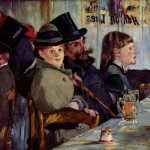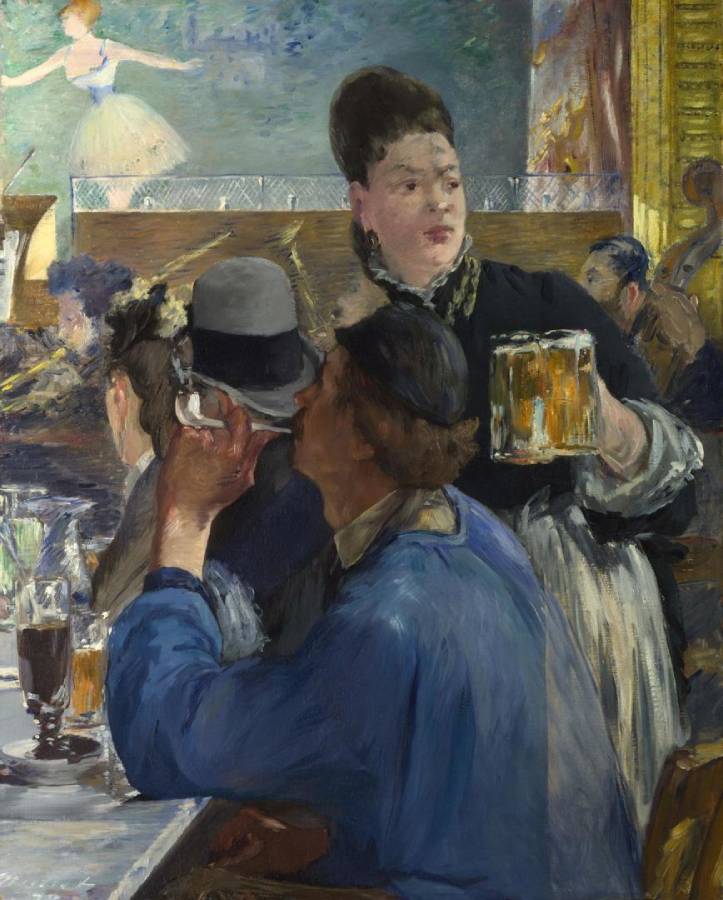Manet, Édouard (1832-1883)
Coin d’un café-concert (Corner of a Café-Concert)
probably 1878–1880
Oil on canvas, 97.1 x 77.5 cm
National Gallery, London
In the middle of the nineteenth century the café-concert became extremely popular in France, and Parisian establishments such as the Ambassadeurs, the Alcazar d’été and the Nouvelle Athènes attracted customers from all classes. These venues were also fashionable meeting places for artists and writers, particularly those associated with the Impressionists. In 1870 Manet left his studio in rue Guyot in the west of Paris – where he had painted his Portrait of Eva Gonzalès – and set up his studio and home close to Place Clichy and Place Pigalle. From 1872 until his death in 1883, he produced many works that show the interiors, terraces and gardens of the popular local brasseries, restaurants, cafes and café-concerts.
This snapshot view of cafe society is in fact one (modified) half of a larger painting. In August 1874 Manet began work on a large picture of the Brasserie de Reichshoffen. The art critic Théodore Duret relates how Manet was fascinated by the dexterity of the waitresses ‘who, while placing with one hand a glass on a table in front of a customer, were able to hold several more in the other, without spilling a drop.’ Manet asked the most skilled waitress to pose for him in his studio, which she agreed to do, but only on condition that she was accompanied by her ‘protector’, who would also require payment. He is the man in a blue smock leaning on the table as the waitress sets down a glass of beer before him.
While working on the picture, Manet radically altered his plans and cut it in two, completing each half separately. The right half (this painting) shows the waitress, while the left half shows a man and two women sitting at the other side of the table. Titled Au café, that painting is in the Reinhart Collection, Winterthur, Switzerland. Although Manet reworked each painting separately, it is still clear that they are two halves of the same picture. For example, the table on the left of this picture joins with the table on the right of Au café, and the shadows of the glasses and carafes continue over the join. At the very left edge of the National Gallery picture, the fingertips of the young woman who sits on the opposite side of the table in the Reinhart painting are just visible.
Manet enlarged the National Gallery picture by adding an extra strip of canvas along its right side – a join runs through the man’s blue smock, roughly in line with the satin curtain in the top right corner. By adding this extra canvas, Manet brought the waitress into the centre of the composition. He then reworked the background, adding the stage, the dancer and the orchestra, which are painted in a much looser manner than the foreground figures.
Although a picture in its own right, Corner of a Café-Concert is also a fragment. But this is appropriate for its subject, as Manet offers us just a fleeting glimpse into this world, not a panoramic view of it. In this, it has similarities with At the Café de Châteaudun by Degas, which also focuses on just two people. Another smaller version of this picture is also in the Musée d’Orsay, Paris, which may be a preparatory study for this one once Manet had divided the original, larger painting. (NG)
Left side:
 Manet, Édouard (1832-1883)
Manet, Édouard (1832-1883)
Au café
1878
Sammlung Oskar Reinhart, Winterthur
